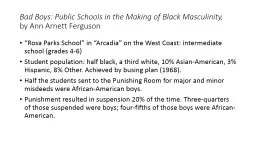

by Ann Arnett Ferguson Rosa Parks School in Arcadia on the West Coast intermediate school grades 46 Student population half black a third white 10 AsianAmerican 3 Hispanic 8 Other Achieved by busing plan 1968 ID: 641876
Download Presentation The PPT/PDF document "Bad Boys: Public Schools in the Making o..." is the property of its rightful owner. Permission is granted to download and print the materials on this web site for personal, non-commercial use only, and to display it on your personal computer provided you do not modify the materials and that you retain all copyright notices contained in the materials. By downloading content from our website, you accept the terms of this agreement.
Slide1
Bad Boys: Public Schools in the Making of Black Masculinity,by Ann Arnett Ferguson
“Rosa Parks School” in “Arcadia” on the West Coast: intermediate school (grades 4-6)
Student population: half black, a third white, 10% Asian-American, 3% Hispanic, 8% Other. Achieved by busing plan (1968).
Half the students sent to the Punishing Room for major and minor misdeeds were African-American boys.
Punishment resulted in suspension 20% of the time. Three-quarters of those suspended were boys; four-fifths of those boys were African-American.Slide2
U.S. Department of Education, Civil Rights Office (March 2014)
Black students represent 16% of student population, but 32-42% of students expelled or suspended
White students represent 51% of student population, and 32-42% of students expelled or suspended
20% of black boys were suspended; 12% of black girls; much higher than their peersSlide3
What is Arnett Ferguson’s argument for why this is happening?Slide4
Judith Butler’s theory of gender as performance, pp. 170-171
Identification of sex difference happens with identification of genitalia at birth
Gender identification happens through routine, ongoing gender performance drawing on well-used scripts and scenarios
How do we signal our gender identity to others? How do we know others’ gender identity?“The enactment of sex difference. . . is a compulsory requirement of social life” (Arnett Ferguson 2001, p. 171). Do you agree or disagree?
Coercion/freedom not so different? Perhaps we are coerced into gender identification but also find it as a site of freedom and self-makingSlide5
“The Fire on the 57 Bus in Oakland,” New York Times,
January 29, 2015
Sasha Fleischman, age 18, identifies as
agender, neither male nor femaleOn way home from school, wearing a skirt, and fell asleepSlide6
What is the role of school in the boys’ performance of masculinity?
What are the long-term consequences of being a Troublemaker?
What recommendations might you make to schools to change this?